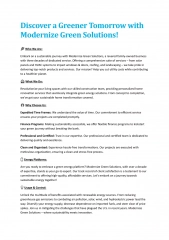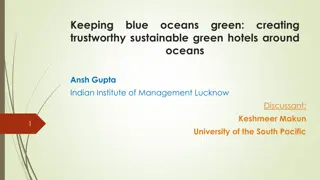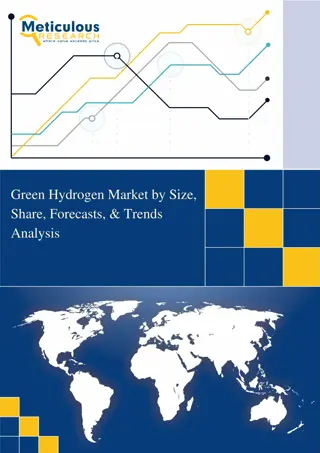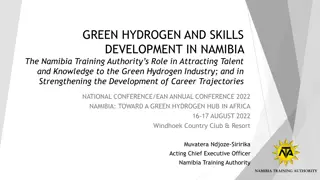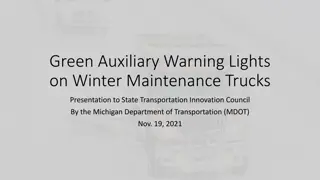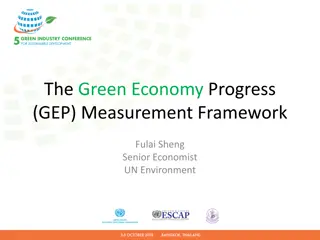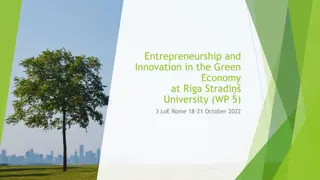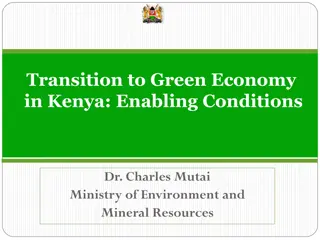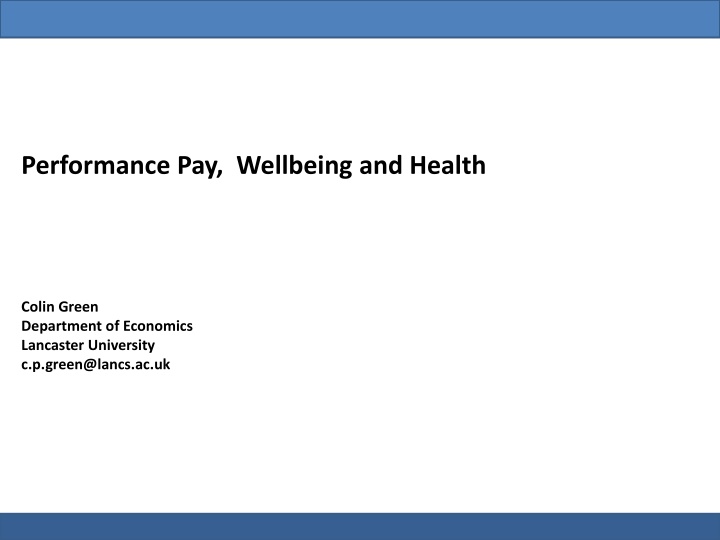
Improving Work Performance with Performance Pay
Explore the impact of performance pay on employee behavior and productivity in the realm of economics, focusing on how contracts can influence outcomes positively or negatively. Discover the various mechanisms through which performance-related pay structures can shape behavior and incentivize effort within organizations.
Download Presentation

Please find below an Image/Link to download the presentation.
The content on the website is provided AS IS for your information and personal use only. It may not be sold, licensed, or shared on other websites without obtaining consent from the author. If you encounter any issues during the download, it is possible that the publisher has removed the file from their server.
You are allowed to download the files provided on this website for personal or commercial use, subject to the condition that they are used lawfully. All files are the property of their respective owners.
The content on the website is provided AS IS for your information and personal use only. It may not be sold, licensed, or shared on other websites without obtaining consent from the author.
E N D
Presentation Transcript
Performance Pay, Wellbeing and Health Colin Green Department of Economics Lancaster University c.p.green@lancs.ac.uk
Introduction Large (economics) literature on performance pay Main focus on how performance pay solves agency problems For instance firm owners are profit maximisers, while worker utility is a positive function of pay and negative function of effort Intuition is that payment on output better aligns worker and firm objectives PRP can take many forms but basic models consider contemporaneous output based pay (i.e. piece rates, commissions etc) Classic work is Lazear s 2000 AER paper on Safelite window replacements Switch to piece rates leads to large increase in worker productivity Little increase in direct labour costs.
When Good Contracts Go Bad At the same time development of literature focusing on perverse behaviour under performance pay. Gaming, Multi-tasking etc. Why? 1. Useful to think about potential limitations to use of performance pay 2. Importance of careful contract design 3. Empirical literature often focuses on whether performance pay increases productivity but forgets about firm s objective, i.e. profits. - famously Freeman and Kleiner, 2005 IR paper shows how a firm can switch from piece rates to time rates, productivity can go down, but profits rise
How Do PRP Contracts Change Behaviour? 2 ways (not mutually exclusive) 1. The standard piece rate model is about effort Workers respond to output based incentives by working harder Actually in terms of labour supply it is not clear what harder means i.e. at the intensive margin (less shirking) or extensive margin (longer hours) 2. Change decision making to be more aligned with firms. Paying bonuses to traders isn t about working harder but incentivising correct decision making. Company owners are risk neutral worker is risk averse so will not take the right risks Payment on performance incentivises them to maximise expected returns from investments In both dimensions sorting is also important - PRP seeks to attract more productivity, more risk taking workers.
How Piece Rates Incentivise Effort Contrast effort choice on salary (w=salary) with minimum output requirement w=-s+bQ U1 piece rate output/effort, wage choice (conditional on participation piece rate increases effort and wages) U0 w* So performance pay allows for higher effort (output) pay combinations salary q,e q* q0
Does PRP Change Behaviour? Easiest to look at labour supply response at margin of hours worked Dependent Variable total hours worked (inc Overtime) (I) Demonstrates that on average PRP jobs are associated with longer hours British Household Panel Survey (BHPS) 1997 - 2008 (I) (II) (III) (II) The within worker effect. A given worker exposed to PRP works harder (but note smaller magnitude) Individual PRP 1.751*** (0.120) 1.144*** (0.0942) 45.47*** (0.509) 0.378*** (0.103) 0.471*** (0.0834) 42.49*** (0.570) 0.253** (0.0990) 0.206** (0.0818) 41.25*** (0.623) Bonus/Profit Share (III) The within worker-job effect. A worker doing a specific job works harder under PRP. Constant (difference between II & III suggests that shifts from PRP involve some change in jobs ) Worker Fixed Effects X Match Fixed Effects X Observations R-squared Number of pid Number of match id 76,042 0.247 76,042 0.064 18,981 76,042 0.040 Harder to find credible evidence on intensive effort / risk taking 28,892 Standard errors in parentheses *** p<0.01, ** p<0.05, * p<0.1 All regressions include occupation, industry, education, pay, year and region controls.
And Pay is higher No lack of evidence that worker s are rewarded for taking PRP contracts (see for instance Daniel Parent s work with various co-authors in US) For UK less evidence but for instance effect of performance pay on log hourly earnings: BHPS 1997-2008 (I) Large raw premium (I) (II) (III) (II) Much of this is sorting PRP 0.183*** (0.00853) 0.171*** (0.00670) 2.614*** (0.0350) 0.0616*** (0.00775) 0.0524*** (0.00625) 2.510*** (0.0414) 0.0267*** (0.00764) 0.0152** (0.00631) 2.616*** (0.0465) Bonus/Profit Share (III) Even more from the type of job Constant But still premiums associated with this pay (and bonus/profit share may miss larger periodic payments) Worker Fixed Effects Match Fixed Effects Observations R-squared Number of pid Number of matchid X X 76,131 0.375 76,131 0.164 19,016 76,131 0.109 28,943 Standard errors in parentheses *** p<0.01, ** p<0.05, * p<0.1 All regressions include occupation, industry, education, pay, year and region controls.
What Happens at the Margin? Intrinsic Motivation and Wellbeing Does this entirely describe the trade-off? i.e. workers who choose PRP do so as it allows them to trade-off hours/effort for more pay? Put another way, is there movement at any other margin? A range of research has considered whether PRP comes at further costs to the worker in the form of: 1. Job satisfaction and wellbeing 2. Health 3. Time-Squeeze on other private activities, including leisure, family and activity that may foster social capital Remainder of this talk will focus on these issues (BTW answer is (1)No, (2)Yes, and (3) not sure)
What Happens at the Margin? Intrinsic Motivation and Wellbeing A standard complaint in the Industrial Relations literature is that PRP crowds out intrinsic motivation. It robs workers of the warm glow from doing a good job. Transforms interaction between firm and worker into a cold market transaction. No one way to test this but satisfaction with the job seems as good as any: Q: Does moving on to performance pay reduce job satisfaction? Again look at BHPS
What Happens at the Margin? Intrinsic Motivation and Wellbeing A standard complaint in the Industrial Relations literature is that PRP crowds out intrinsic motivation. It robs workers of the warm glow from doing a good job. Transforms this into a cold market transaction. No one way to test this but satisfaction with the job seems as good as any: Q: Does moving on to performance pay reduce job satisfaction? Again look at BHPS
Intrinsic Motivation and Performance pay (originally looked at in Green and Heywood, 2008 Economica) here with updated data BHPS 1998-2008. (1) (2) (3) (4) No robust negative effect in fact PRP associated with higher job satisfaction VARIABLES Exclude Bonuses Quartiles bonuses< 1,000 p.a. PRP -0.0292** (0.0130) 0.0829*** 0.0298** (0.0146) 0.00566 0.0431** (0.0175) 0.0431** 0.0254* (0.0153) Some evidence that large bonuses are associated with more job satisfaction Bonus/Profit Share (0.0102) (0.0116) (0.0195) Bonus (quart 1) 0.00138 (0.0193) -0.00657 (0.0190) -0.0213 (0.0194) 0.0357 (0.0239) X Perhaps this misses the point? Bonus (quart 2) Maybe PRP comes at the cost of lower satisfaction in life more generally? Bonus (quart 3) Bonus (quart 4) Worker FE X X Constant 6.472*** (0.0670) 5.508*** (0.0754) 5.488*** (0.0862) 5.536*** (0.0783) Observations R-squared Number of pid 88,170 0.030 88,170 0.007 20,986 72,518 0.007 19,540 84,513 0.008 20,465
Intrinsic Motivation and Performance pay Life-satisfaction (happiness) and performance pay (1) OLS (2) FE (3) (4) exclude small bonuses bonus quartiles Again if anything PRP and bonuses (esp. big ones) make you happier! PRP 0.0210* (0.0124) 0.0483*** (0.00977) 0.00894 (0.0122) 0.0101 (0.00987) 0.0147 (0.0148) 0.0356** (0.0165) 0.00929 (0.0128) Bonus/Profit Share Bonus (quart 1) 0.0112 (0.0168) 0.00435 (0.0159) -0.00151 (0.0160) 0.0337* (0.0197) 5.452*** (0.0693) (And note this is holding earnings constant!) Bonus (quart 2) Bonus (quart 3) Bonus (quart 4) Constant 6.574*** (0.0665) 5.508*** (0.0661) 5.497*** (0.0770) Observations R-squared Number of pid 73,798 0.024 73,798 0.005 19,082 60,516 0.005 17,663 71,129 0.005 18,958
Performance pay and health If PRP leads to worker s increasing effort or taking behaviour could this be bad for workers in the long run? Workmen. . . when they are liberally paid by the piece, are very apt to overwork themselves, and to ruin their health and constitution in a few years (Smith 1776, p. 83). A small body of research has developed demonstrating a link between performance pay and health. This link is important as part of the wage premium may be a risk premium . And also matters who foots the health bill (employers, the worker or the state) i.e. is there a potential for moral hazard? Two versions of this: (1) contemporaneous effect accidents/injuries through extra effort, poor maintenance of equipment etc - Relatively straightforward to test - Bender, Green and Heywood (2011) J.PopEcon one study that looks at cross-European evidence on health effects of working in PRP
Manual Workers and Injuries Cross European Evidence Payment Methods and Probability of Workplace Injury, Probit Marginal Effects, EWCS 2000 & 2005. (Large) Increase in workplace injury due to piece rates All Manual Workers 0.067* [0.017] -0.014 [0.021] 0.079 [0.057] 0.010 [0.044] 0.070* [0.011] 0.001 [0.003] -0.0002 [0.0004] 0.039 12,860 Non-Manual Workers 0.014** [0.008] -0.009 [0.008] 0.007 [0.010] -0.013 [0.010] 0.012** [0.005] 0.001 [0.001] -0.00018 [0.00013] 0.037 20,641 Piece Rate Profit Share Group Bonus Share Payment Male Age Age Sqr * 10 Pseudo r2 Observations 0.052* [0.009] -0.024* [0.007] 0.019 [0.022] -0.016 [0.014] 0.060* [0.004] 0.0005 [0.002] -0.0001 [0.0002] 0.056 33,501 Concentrated in manual work These effects survive detailed controls for workplace hazards and relatively detailed controls for effort (in fact controlling for effort does not change piece rate effect at all) So a slight puzzle re: transmission mechanism Can conduct similar exercise for UK on PRP
PRP and Self-Assessed Health BHPS, Performance Pay and Self-Assessed Health (1 = excellent, ,5 very poor) (1) OLS (2) (3) (4) (5) Worker FE -0.00848 (0.00931) Match FE -0.0142 (0.0103) exclude small bonuses -0.0103 (0.0112) bonus quartiles -0.00743 (0.00978) -0.000958 (0.0127) -0.00406 (0.0120) -0.00466 (0.0121) 0.00174 (0.0147) PRP -0.0335*** (0.00911) Bonus (quart 1) Bonus (quart 2) Bonus (quart 3) Bonus (quart 4) Bonus/Profit Share -0.0309*** (0.00711) 1.790*** (0.0785) -5.54e-05 (0.00740) 1.795*** (0.0754) -0.0115 (0.00844) 1.867*** (0.0911) -0.00262 (0.0123) 1.884*** (0.0670) Constant 1.836*** (0.0779) Observations R-squared Number of pid Number of matchid 75,438 0.021 75,438 0.004 19,202 75,438 0.005 62,121 0.004 17,788 72,793 0.004 19,086 29,235 Standard errors in parentheses *** p<0.01, ** p<0.05, * p<0.1
Performance pay and stress No effect but perhaps this misses long term effects of PRP on health, for instance due to overwork/stress/reduction in healthy behaviours. Naturally harder to test Bender and Theodossiou (OEP, forthcoming) is one attempt. BHPS Looks at relationship between exposure to PRP and likelihood of exiting good health. In essence takes workers in an initial period in good health and compares survival in good health of those on PRP to those not.
PRP Exposure and long term health (Bender and Theodossiou) Survival in good health over years Conditional on exposure to PRP Markedly lower survival rate
PRP and Health This (and other papers, Artz and Heywood ) lead to a picture of a negative health effect of PRP . If understood by workers means that part of the wage premium needs to be viewed in a compensating wage differential light. But little known about transmission mechanism
PRP at the Margin PRP works by increasing the private return to increased effort. A natural question is to ask is does this squeeze out other activities. If, so what types of activities. Is there a market failure dimension? One concern is that it influences the provision of goods with a social value. For instance: (1) PRP works best on high ability individuals these may be those who have high social value in other activities (charities, organisations etc) (2) Increased work may influence other outcomes that have social consequences family stability? (3) A reduction in leisure time that my be best co-consumed Little work on this... 1st question does PRP influence leisure outcomes of individuals lack of information in most data sets.
Effect on Leisure Satisfaction with Amount of Leisure? BHPS 1998-2008 (1) OLS (2) FE (3) (4) (5) Some evidence that PRP reduces satisfaction with leisure amount match exclude small bonuses FE bonus quartiles FE PRP -0.0337** (0.0162) -0.0279* (0.0161) -0.0176 (0.0175) -0.0167 (0.0194) -0.0194 (0.0169) 0.0264 (0.0222) -0.00261 (0.0210) -0.0321 (0.0211) -0.0494* (0.0260) Might indicate greater time pressure for individuals on PRP Bonus (quart 1) Bonus (quart 2) Is there any evidence of what else might be reduced at the margin? Bonus (quart 3) Bonus (quart 4) Bonus/Profit Share 0.0150 (0.0128) 6.084*** (0.0906) -0.0111 (0.0130) 4.985*** (0.110) 0.00223 (0.0145) 4.779*** (0.112) -0.0105 (0.0216) 4.694*** (0.104) Constant 4.668*** (0.0943) Observations R-squared Number of pid Number of matchid 73,945 0.037 73,945 0.009 19,094 73,945 0.009 60,645 0.010 17,674 71,269 0.009 18,967 29,097 Standard errors in parentheses *** p<0.01, ** p<0.05, * p<0.1
PRP and Outside Activities Cross-European evidence Appears that PRP comes solely at the expense of housework (no effect for women) But no effect on child care, charitable activity or leisure. (unreported BHPS estimates suggest no effect on involvement with charities.) Standard errors in parentheses *** p<0.01, ** p<0.05, * p<0.1
PRP and Marriage Stability Given the margin that is being substituted away from (housework) does this have implications for marriage. Consider a group of married, male heads of households Does PRP affect the likelihood of marriage dissolution? Preliminary evidence suggests no effect within the next year. But perhaps an approach as per Bender and Theodossiou is the way forward.
Conclusions Empirical evidence fits with basic model of how PRP mitigates agency problems. By tying pay to performance, workers can choose higher effort, wage combinations than available on time rates. With this said, UK evidence suggests a small return to PRP once worker and job are controlled for. This return may be even smaller once the potential for poorer health outcomes are accounted for. Evidence on this is not conclusive, but suggests PRP associated with more injuries in the short term, and worse health in the long term. Harder to get at what margin individuals substitute from towards more work. More work needed here, but initial research suggests that this substitution may be confined within the household.

